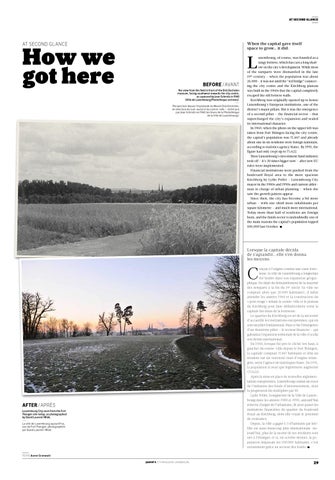At second glance
At second glance
How we got here
When the capital gave itself space to grow… it did.
L before / avant The view from the field in front of the Dräi Eechelen museum, facing southwest towards the city centre, as captured by Jean Schmitz in 1960 (Ville de Luxembourg Photothèque archives). ---Perspective depuis l’esplanade du Musée Dräi Eechelen, en direction du sud-ouest et du centre-ville – cliché pris par Jean Schmitz en 1960 (archives de la Photothèque de la Ville de Luxembourg).
uxembourg, of course, was founded as a rangy fortress, which has cast a long shadow on the city’s development. While most of the ramparts were dismantled in the late 19th century – when the population was about 26,000 – it was not until the “red bridge” connecting the city centre and the Kirchberg plateau was built in the 1960s that the capital completely escaped the old fortress walls. Kirchberg was originally opened up to house Luxembourg’s European institutions, one of the district’s major pillars. But it was the emergence of a second pillar – the financial sector – that supercharged the city’s expansion and sealed its international character. In 1960, when the photo on the upper left was taken from Fort Thüngen facing the city centre, the capital’s population was 71,667 and already about one in six residents were foreign nationals, according to statistics agency Statec. By 1991, the figure had only crept up to 75,622. Then Luxembourg’s investment fund industry took off – it’s 30 times bigger now – after new EU rules were implemented. Financial institutions were pushed from the boulevard Royal area to the more spacious Kirchberg by Lydie Polfer – Luxembourg City mayor in the 1980s and 1990s and current alderman in charge of urban planning – when she saw the growth pattern appear. Since then, the city has become a bit more urban – with one-third more inhabitants per square kilometre – and much more international. Today more than half of residents are foreign born, and the funds sector is undoubtedly one of the main reasons the capital’s population topped 100,000 last October.
.
Lorsque la capitale décida de s’agrandir… elle s’en donna les moyens.
C
onçue à l’origine comme une vaste forteresse, la ville de Luxembourg a longtemps été bridée dans son expansion géographique. En dépit du démantèlement de la majorité des remparts à la fin du 19e siècle (la ville ne comptait alors que 26 000 habitants), il fallut attendre les années 1960 et la construction du « pont rouge » reliant le centre-ville et le plateau du Kirchberg pour faire définitivement sortir la capitale des murs de la forteresse. Le quartier du Kirchberg est né de la nécessité d’accueillir les institutions européennes, qui en sont un pilier fondamental. Mais ce fut l’émergence d’un deuxième pilier – le secteur financier – qui galvanisa l’expansion territoriale de la ville et scella son destin international. En 1960, lorsque fut pris le cliché (en haut, à gauche) du centre-ville depuis le Fort Thüngen, la capitale comptait 71 667 habitants et déjà un résident sur six (environ) était d’origine étrangère, selon l’agence de statistiques Statec. En 1991, la population n’avait que légèrement augmenté (75 622). Après la mise en place de nouvelles réglementations européennes, Luxembourg connut un essor de l’industrie des fonds d’investissement, dont la progression fut multipliée par 30. Lydie Polfer, bourgmestre de la Ville de Luxembourg dans les années 1980 et 1990, aujourd’hui échevin chargée de l’urbanisme, fit alors passer les institutions financières du quartier du boulevard Royal au Kirchberg, dont elle voyait le potentiel de croissance. Depuis, la ville a gagné 1/3 d’habitants par km2. Elle est aussi beaucoup plus internationale. Aujourd’hui, plus de la moitié de ses résidents sont nés à l’étranger, et si, en octobre dernier, la population dépassait les 100 000 habitants, c’est notamment grâce au secteur des fonds.
after / a près Luxembourg City seen from the Fort Thüngen site today, as photographed by David Laurent/Wide. ---La ville de Luxembourg aujourd’hui, vue du Fort Thüngen, photographiée par David Laurent / Wide.
.
TEXTE Aaron Grunwald JASON’S CITY MAGAZINE LUXEMBOURG
29
